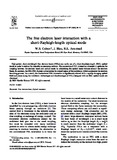The free electron laser interaction with a short-Rayleigh-length optical mode
| dc.contributor.author | Colson, W.B. | |
| dc.contributor.author | Blau, J. | |
| dc.contributor.author | Armstead, R.L. | |
| dc.date.accessioned | 2014-12-09T21:48:50Z | |
| dc.date.available | 2014-12-09T21:48:50Z | |
| dc.date.issued | 2003 | |
| dc.identifier.citation | Nuclear Instruments and Methods in Physics Research A, Volume 507, (2003), pp. 48â 51 | |
| dc.identifier.uri | https://hdl.handle.net/10945/44082 | |
| dc.description | The article of record as published may be located at http://dx.doi.org/10.1016/S0168-9002(03)00835-0 | en_US |
| dc.description.abstract | High-power, short-wavelength free electron lasers (FELs) can make use of a short-Rayleigh-length (SRL) optical mode in order to reduce the intensity on resonator mirrors. The conventional FEL interaction attempts to optimize the coupling between the electron beam and optical mode by minimizing the optical mode volume around the electron beam. In contrast, the SRL FEL focuses optical power in a small region of the undulator, which accelerates the electron bunching process. As a result, the fundamental FEL interaction is significantly altered with a rapidly changing optical field and phase along the undulator. Advantages and disadvantages of FELs designed with an SRL optical mode are discussed. | en_US |
| dc.rights | This publication is a work of the U.S. Government as defined in Title 17, United States Code, Section 101. Copyright protection is not available for this work in the United States. | en_US |
| dc.title | The free electron laser interaction with a short-Rayleigh-length optical mode | en_US |
| dc.type | Article | en_US |
| dc.contributor.department | Physics | |
| dc.subject.author | Free electron laser | en_US |
| dc.subject.author | Optical resonator | en_US |
| dc.description.funder | The authors are grateful for the support from NAVSEA, JTO, DARPA and ONR. | en_US |





